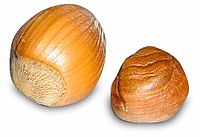
Photo from wikipedia
Purpose of review Tree nut (TN) and seed allergies are frequent, and their prevalence appears to be on the rise. Allergic reactions associated with these foods are more frequently severe,… Click to show full abstract
Purpose of review Tree nut (TN) and seed allergies are frequent, and their prevalence appears to be on the rise. Allergic reactions associated with these foods are more frequently severe, and these allergies tend to persist into adulthood, consequently affecting quality of life. In this review, we summarize recent advances in diagnostic modalities and management strategies for TN/seed-allergic patients. Recent findings Clinical manifestations of TN and seed allergy range from asymptomatic sensitization to severe anaphylactic reactions. The use of emerging diagnostic tools such as component resolved diagnostics (CRD) and the basophil activation test (BAT) can help better predict clinical reactivity, the latter being currently reserved for research settings. Strict avoidance of all TN is generally not required, as most patients can tolerate select TN despite co-sensitization. Oral immunotherapy (OIT) is a promising alternative treatment instead of complete avoidance of culprit allergens, as it can safely increase the allergy threshold. Summary Our recent understanding of co-reactivity between various TN and seeds has shaped management opportunities, including select TN introduction and optimization of OIT, two strategies which may improve quality of life. There is a need for better minimally invasive diagnostic methods for TN and seed allergy, with CRD and BAT being promising tools.
Journal Title: Current Opinion in Allergy and Clinical Immunology
Year Published: 2022
Link to full text (if available)
Share on Social Media: Sign Up to like & get
recommendations!